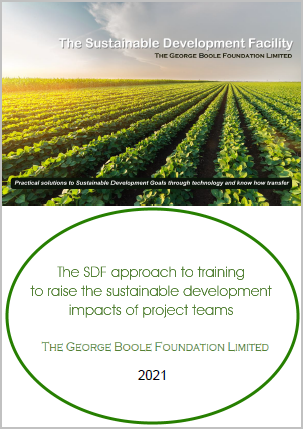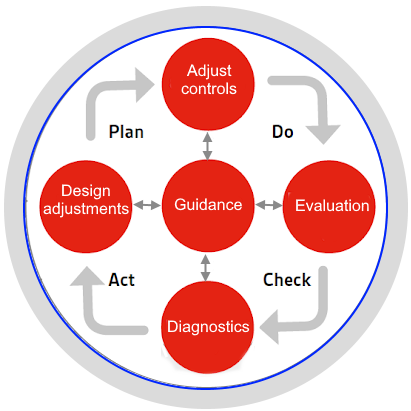TrainingA document providing an explanation of form of project team training provided under SDF projects can be accessed by clicking on the image below. |
Training approach
Although all recommendations and procedures are based on explicit knowledge, the OQSI training guidelines emphasize the development of trainee cumulative tacit knowledge through repetitive cycles of action, observation, adjustment and improvement of tasks. This approach is based on SEEL's instructional simulation approach and the ISO process approach. This approach results in a constant increase in quality standards as a result of the learning curve.

Source: ISO 9001; OSQI 2020; SEEL IS:2020. |
|
|
By receiving support through a donor funded George Boole Foundation Extension Service (GBFexs) operating within the SDGToolkit framework, beneficiaries will acquire expert training in advanced project design due diligence procedures and receive instructions on when and how to use analytical tools to identify and manage critical information to establish evidence to identify project design options.
The main purpose of the training content of the SDF initiative is to establish project teams with very high levels of practical competence in designing and managing projects in an effective manner. Although course content contains theory and logic, the fundamental objective is to assist course participants build up tacit knowledge as to "to know what, why and how to do" by being trained on-the-job engaged in real projects. Training is based on a process approach.
This system enables teams to analyse relevant information on gaps and needs at the national level as well as identify and quantify the principle constraints facing project implementation. The training takes beneficiary personnel through a range of factors of relevance to the identification of sustainable solutions that take into account real incomes impacts as well as carbon footprint analysis so as to identify optimized projects that can deliver:
- a viable financial return
- reduced income disparity
- reduce carbon footprint
- carrying capacity balance
- and quantified impact analysis on specific environmental and ecosystem issues identified as being critical
|
The database system acts as a Project Memory so that loss of team personnel does not disrupt ongoing work because newcomers can be brought up to speed in the short period of time. An onboard internal evaluation system enables teams members to assess project performance and in cases of delays in completion of tasks arising from changed conditions the options simulations can be used to orientate decisions made. The evaluation system can also be used to record the effectiveness of decisions.
The process approach
The main advantages
The ISO summaries the benefits of the process approach as:
- Integration and alignment of all processes to achievement of objectives
- Efforts in focused on process effectiveness and efficiency
- Improvement of confidence to donors and management concerning consistent high performance of teams
- Transparency of operations
- Learning to lower costs, reduce delays and use resources more effectively
- Improved, consistent and predictable results
- Identification of ways to improve overall performance
- Full team involvement and well-defined responsibilities
Additionally the SDGToolkit procedures and AT components provide an integrates systems approach. |
|
|
The OQSI evaluation criteria help project teams by providing specific guidance on how these should be applied according to project phases and tasks because the evaluations in each case focus on different types of activity and performance according to the specific phases, including:
- Design
- Setup
- Operations (completion of tasks)
- Operational decisions and outcomes
- Post-funding design adjustment for long term sustainability
|
To support evaluation the SDGToolkit has "internal evaluation" tools that record results in a Project Memory remaining accessible to donors, beneficiaries and external evaluators. By involving project teams in internal evaluations the "lessons learned" are more easily internalized so as to improve the professional know how of the team as well as remaining in the Project Memory to help avoid similar issues occurring in future project designs.
OECD DAC consider their evaluation criteria to be normative but provide no tools or detailed guidance on how to apply them to these different phase activities. The OQSI review (2010-2015) found that as a result, evaluations are of varying quality and quite often do not include team members; in some cases external evaluations are not welcomed.
With the advent of SDGToolkit, evaluation is considered to be an essential internal team function to stimulate professional enquiry and competence through a positive learning attitude with no negative connotations. The result is a very well-informed and increasingly competent team able to provide more expert support to external evaluators and design better projects in the future.

 |



